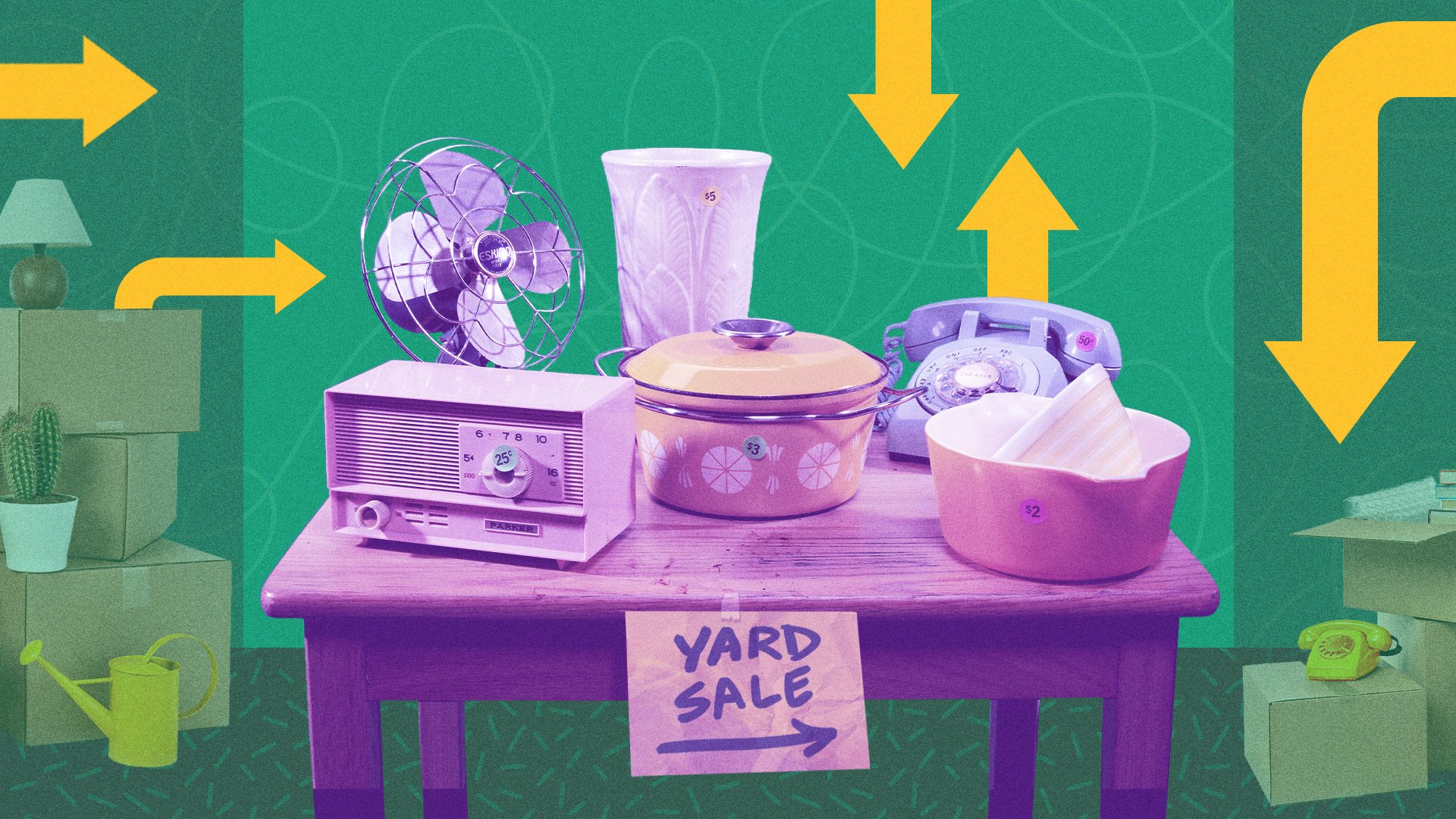There is a moment during every big move where it hits you: Moving is really freaking expensive. The expenses—from packing supplies and the truck itself to the costs related to cleaning, painting, and utility deposits—will pile up. And I’m not even including the costs of furniture that better fits your new space.
Budget—and cushion your budget
I spoke to a number of moving experts—especially people who work at moving companies and have been in the business for years—and most of them emphasized budget before your move—and overestimating what you think you’ll spend. Both Shannon Beller, CEO and co-founder of Wall-Russ, and Rob Rimeris, owner of EverSafe Moving Co., say you should add 10 to 15% to your final budget as a cushion. Rimeris says that “isn’t just practical,” but “gives people back a sense of agency when plans shift.”
A few often-overlooked expenses that came up included these: tips for your movers (as well as insurance) fuel for the truck or car if you are moving some or all of your possessions, cleaning fees for the place you move into or out of, repairs for your old home, unforeseen extra charges from the movers, and furniture assembly.
But wait, there’s more: “It may not seem critical at first, but planning for food and takeaway expenses is also important,” says Shanaiqua D’sa, content marketing lead at Attic Self Storage. “You’re unlikely to cook on moving day or even in the days immediately following, especially if your kitchen isn’t fully set up yet or you’re simply too tired.” Kids and pets, too, “slow down the moving process,” she says, so you might want to arrange for someone to look after them.
Only move what’s necessary
You’re already overwhelmed by how much you have to do and I totally get that, but this is a perfect opportunity to declutter your stuff. In fact, decluttering was cited as a top money-saving tip by many pros: “The biggest mistake we see people make time and time again is underestimating how much stuff they have,” says Charles Chica, co-owner of CT Best Moving.
“Get rid of anything you do not need because the less stuff you have, the cheaper the move will be,” adds Marshall Aikman, owner of Amazing Moves Moving & Storage.
Sell what you can and buy what you need (used)
Consider selling some of what you’re getting rid of, as long as you start with enough lead time before your moving day. D’sa points out that you can generate money for the move by offloading old stuff to buyers. If you have enough time between decluttering and moving, list furniture and clothes on sites like Poshmark and Mercari. If you don’t have much time, keep it local and stick with Facebook Marketplace, where buyers can come pick up furniture and other objects directly from you and hand over cash. The last time I moved, I listed furniture on Facebook Marketplace and promised myself that if it didn’t sell before I left my old place, I had to take it as a loss and donate it, but as Evan Hock, co-founder of MakeMyMove points out, you can also list it in Buy Nothing groups as a free pickup. Whatever it takes to get it out of your space!
If you really have enough lead time, organize a rummage sale. It’s not as easy to coordinate if you live in a larger city, although I’ve certainly seen it done, but I grew up in a rural place where this was the norm. As long as you’re doing it on private property, most jurisdictions don’t require a permit for a short-term yard sale, but please check. Put up a few signs, post some ads on Craigslist, and haul all your for-sale wares to your garage or front lawn. Be prepared to take lowball offers and haggle a little, but you’ll be surprised by how much actually sells. You can (and should) list it all on the aforementioned apps and digital marketplaces, too, then donate whatever is left over before the move.
If you’re moving to a bigger home, online resale and yard sales are also how I recommend filling it—at least at first. Moving is a massive expense, and it might not be feasible to buy or finance big furniture sets from retail stores at first. On the other hand, occupying a near-empty house is a bummer. Buy used essentials to save money and get your home in order. You can re-list it and sell it if and when you’re more settled in and financially prepared for better furniture—or you may even fall in love with your eclectic decor collection and keep it.
Go “stooping”
There is another, even less-expensive option if you need furniture fast. If you live in a big city, you’re familiar with the classic practice of picking up free furniture from the sides of the street. If you live in New York and spend time on Instagram, you’re also probably familiar with the account that makes doing that even easier.
@StoopingNYC has 479,000 followers who dutifully snap pics of discarded furniture throughout the five boroughs and DM it to the account owners, along with location details. The owners, in turn, post the photos and relevant information on the account’s story as well as on the grid, encouraging New Yorkers to have at it.
“Stooping is the act of hunting down discarded street freebies that has the added benefit of being both an activity you can do outdoors and one that ultimately enriches the space where you’re most likely spending all of your time: your apartment or house!” the couple behind @StoopingNYC tells me.
If, instead, you don’t live in a big city where stooping is regularly practiced, snag some stuff on the cheap by mapping out the weekend’s best local yard sales or head to all the online marketplaces where you’re actively ditching your old stuff to make room for the new (to you) stuff your new place will need. (Craigslist also has a “free” section where people frequently give away items.)
One word of caution in either case: Make sure you clean the products well and proceed with caution when picking out anything made with fabric, like couches or armchairs. You know what’s not inexpensive? Exterminators.
Save on packing supplies
Your budget will include packing supplies like boxes, bubble wrap, and tape, but you should also remember that what you have available can work well to help you pack. You have to move your blankets, towels, clothing, socks, and scarves already, so wrap them around valuables to save some money and space. Per Rimeris, “T-shirts cushion dishes better than bubble wrap ever did.”
Think about nesting, too. Chica says, “Suitcases, laundry baskets, and grocery totes are all great for packing general items.” Again, you’re already taking them with you. Make them help you and save some money on boxes. Many pros also suggested diversifying how you look for boxes. Buying new boxes can be pricy and wasteful, since you’re not going to keep them when you’re done with all this. Instead, ask local shops if you can have some of their boxes. Grocery and liquor stores, for instance, always have a bunch. Just make sure they’re strong and clean.
Movers are great, especially if you have particularly valuable items, a lot of furniture, or a big journey ahead of you. There are other ways to transport your items, however.
Consider enlisting some pals for the big move. Promise pizza and beer or straight-up cash if your friends will help you haul your stuff. They care about you and probably charge less than real movers—but you should also keep in mind that you might also get what you pay for, here.
“Honestly, if you can afford movers, get movers,” said Shannon Palus, a Brooklyn-based writer and editor who has moved more than a dozen times in her life and managed her most recent move for less than $60. “It is really, really nice to have people move your things. I think if you are going the U-Haul-and-friends route, hire someone from a service like Task Rabbit to help with the heavier stuff. I think any money you can spend on moving, you should. They say that you’re supposed to spend money on experiences to be happy, right? Spending your day doing something other than lifting boxes is the ultimate good experience.”
There are ways to compromise here, though. You can hire movers for the big, expensive stuff and hoof it with your friends for the small, cheap stuff. Palus pointed out, too, that her most recent move cost less than $60 because she used ride-sharing apps to hail cars and only had small items to move.
“Be communicative about it, allow [the driver] to decline, and tip really well,” she said. “I also don’t move everything via Lyft; I do some trips on the subway.
If you decide to go for movers, get a written estimate from a few different places. These should outline services, fees, and timing, says Beller. You can even request an itemized estimate upfront to avoid surprise fees. Just be sure you’re being honest when you share your half of the details. Don’t hide that you live in a walk-up, for instance, or own heavy antique furniture. You’re only setting yourself up for surprise fees that way.
Schedule smartly
You don’t always get to pick when we move, especially if you’re moving from rental to rental. That said, if you can, try to schedule your move for off-peak times. Kris Kay, director of operations at UNITS Moving and Portable Storage, says you can usually get lower rates by moving mid-week or mid-month. The summer is the most expensive month for moving because it’s the most common time, too, so if you have any wiggle room there, aim for spring or fall.
Protect your security deposit
There are a few benefits to packing and moving a little on your own before movers show up. Not only do you save money by doing some of your own labor, but you have a chance to scope out your place as you disassemble furniture and box up your stuff. If you’re a renter, you’ll want to try and get your security deposit back, which means cleaning the inside and outside of appliances, wiping down bathroom fixtures and floors, and, of course, fixing any damage. If the damage is minor, try to do it on your own: Patch small holes from picture frames and wall mounts, remove scuffs from walls and floors, and tighten any loose screws. As Chica says, “A minor fix can end up pitting a pretty decent dent in your security deposit.”
When you’re moving, take care not to cause damage, too. Chica says you should never drag furniture. That’s only asking for trouble. When everything is removed from the space, document the condition of the unit with photographs.


























